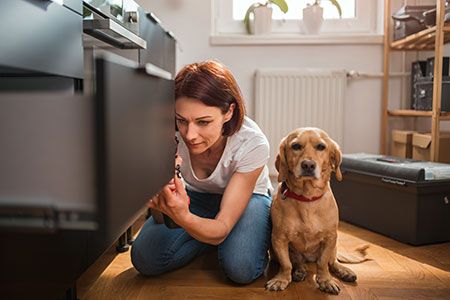Why is our dog urinating on our new cabinet?
A veterinary behaviorist helps sort through whether its a marking issue or a house-training issue.

"That smells different. I'm just waiting until she finishes." (kerkezz/stock.adobe.com)
Editor's note: We received this question from a pet owner on dvm360.com, and after referring her to talk with her own veterinarian, we thought you might have faced similar questions from your clients and would want to see how someone worked through the process of answering. So we sought the advice of one of our favorite veterinary behaviorists on the subject.
Question: My male 17-month-old dog has recently started lifting his leg on a cabinet I just bought from a retail store. He is doggy-door trained so he goes out when he wants. I have cleaned both the cabinet and floor with bleach and vinegar and have even moved the cabinet, but he continues to only pee on that one corner of the cabinet. What's going on with him?
Dr. Albright: To us humans, urine and feces are simply a byproduct of the body ridding itself of waste products. However, to almost every other species, these materials provide lots of information about species, gender, sexual status … and that's just what we know about. “Waste” products probably contain even more information about an individual, such as emotional state or physical fitness. Humans have a wimpy olfactory system compared to most animals. A dog can have up to 150x more primary olfactory bulb nerve cells than a human, and that doesn't include the accessory olfactory, or pheromone, system. Pheromones are chemical communications between members of the same species that convey information and prepare that receiving animal for an important behavior like escape or sex.
We categorize elimination behaviors into two broad categories-toileting and marking. Toileting is elimination motivated by the need to remove waste, whereas marking has a more complex social motivation. Many assume urine marking is always an assertive territorial behavior. But marking with urine or feces can also be an anxiety-driven behavior. Because waste is rich in scent, we believe that the animals are often placing a familiar and probably calming scent in their environment. This is akin to a human placing visually pleasing art or family photos in a room.
More history needs to be obtained to properly diagnose the young adult male dog in this scenario. A thorough physical exam with a urinalysis should be performed. Infection or other urinary tract disease should be ruled out. I'd have a few follow-up questions for this owner:
Does he urinate large amounts or small amounts?Does he urinate in other locations in the home or just this location?
It's possible he is not completely housetrained and this unwanted urination in the house is due to toileting. Free access to the outdoors does not mean the dog will always choose to toilet outdoors. Dogs don't naturally understand they should use the doggy door to eliminate in the grass. This has to be reinforced. A large volume of urine would lead us to suspect a toileting issue and a smaller amount of urine is more likely due to marking or painful urination.
It is likely that he is performing marking behavior. The new or unusual odor of the material and prominent high-traffic location of the heavily “hit” corner could have been a strong factor in the start of the marking behavior, but there may be more to the story.
Is the dog intact?
Social marking is much greater in intact male dogs compared to neutered ones, and urine marking is one of the few problem behaviors that data show is reduced through sexual altering.
When does the dog perform these behaviors?
Urine marking is a common hallmark of separation-related distress, for example, and the owner should have this assessed by a veterinarian or veterinary behaviorist.
Is there other social stress in the home?
This dog may be feeling some stress about another dog or interactions with a person in the home and performing this behavior as a stress-displacement behavior.
The urine odor may continue to draw the animal, and even other animals, to the soiled spot to “mark over” the area, regardless of the original cause. It's difficult to completely remove urine odors. Several smaller studies support enzymatic cleaners to degrade the urine molecules as part of cleaning. Instead of vinegar or bleach, which may be harsh and actually push the dog to mark over the odd smell, the owner could try a commercial enzymatic cleaner (like Anti Icky Poo-G That's Awesome Brands). Once the cleaner has dried, the owner could also try a quality pheromone spray product (like Adaptil-Ceva) to potentially “pre-mark” the area for the dog. Above all, critically assess the underlying stress level with a qualified behaviorist if this continues.
Veterinary scene down under: IV fluid shortage updates, and more news
September 3rd 2024Updates on the intravenous fluid shortage impacting Australian veterinary practices, a welcome funding boost for the Veterinary and Community Care charity, and Australia’s first Fear Free Certified veterinary practice.
Read More